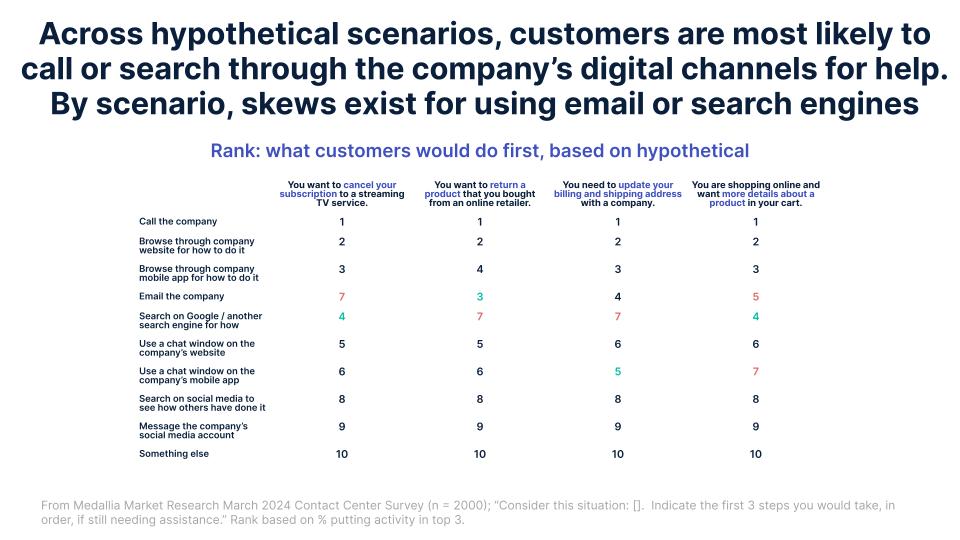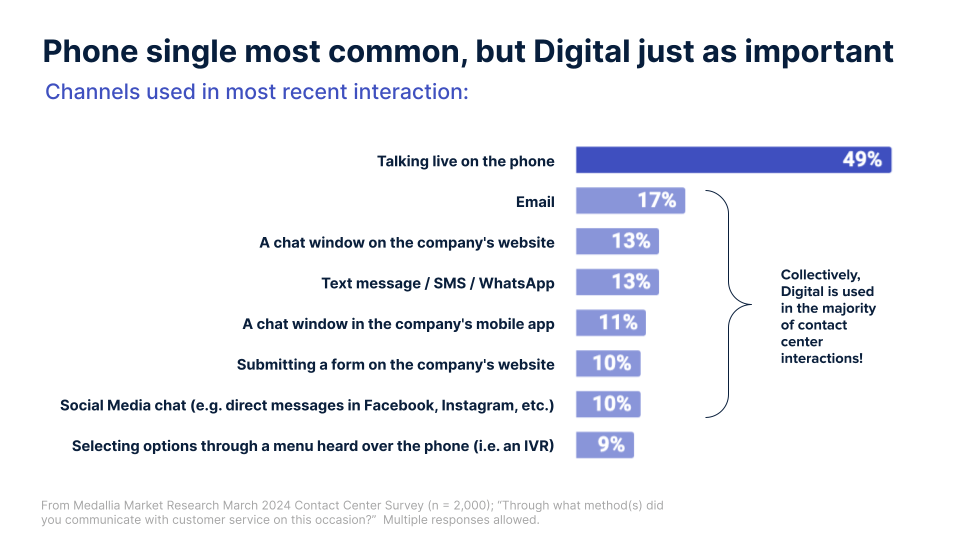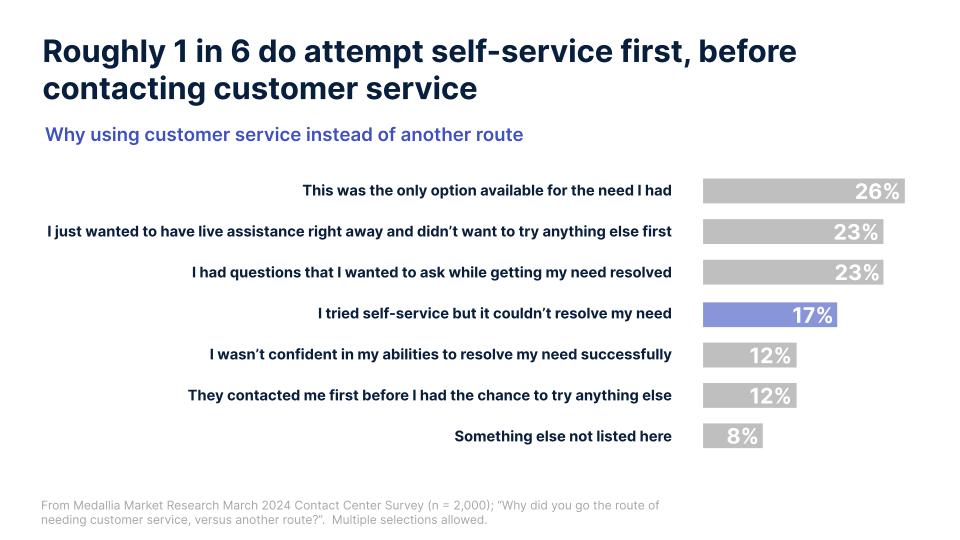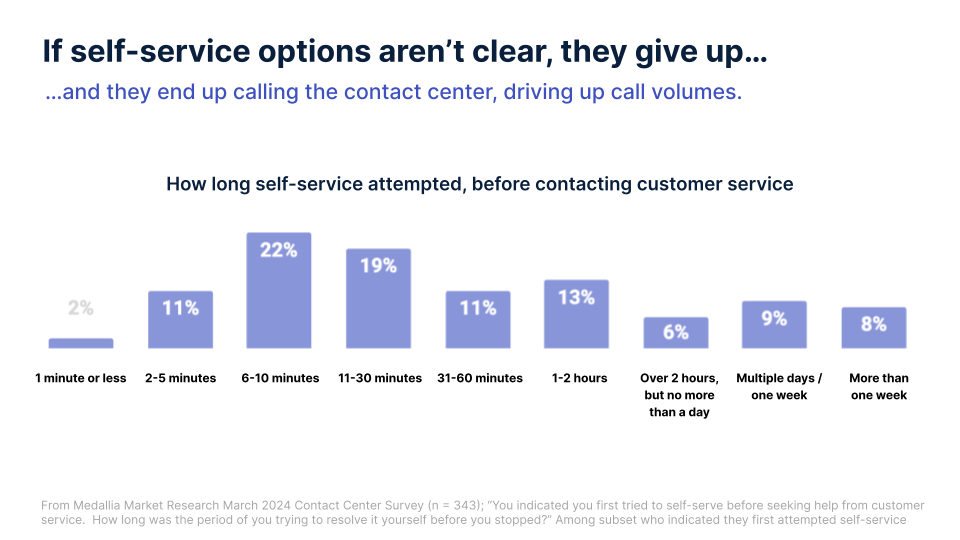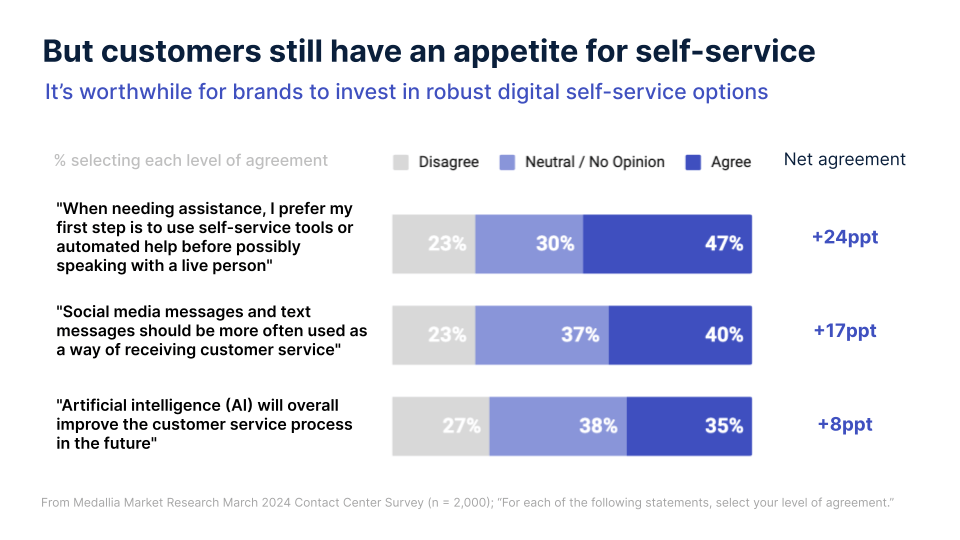Improving the Contact Center Experience: Research-Backed Tactics for Success
May 16, 2024
Contact Center
Learn how to create a stronger customer experience within your contact center using the latest insights from Medallia Market Research.
What are the most effective ways to improve the contact center experience, from the point of view of the customer? Medallia Market Research conducted a survey of 2,000 U.S. consumers to find out.
Medallia’s Head of Market Research Insights, Andrew Custage, revealed the findings from this study in the webinar, Intelligently Using AI: Optimize CX & Contact Center Experiences the Right Way. Here he explains the importance of shorter wait times, shared opportunities for automation, and explored the role of AI and self-service in the customer service landscape.
Here are some highlights of the presentation, including:
- Insights on the importance of the contact center experience
- Top strategies for improving your agents’ call center experience skills and performance, based on the latest consumer research
- Our predictions on how the future of the contact center will evolve over time
Medallia’s Consumer Research Methodology
Medallia offers brands across industries unparalleled market research capabilities, including Medallia Agile Research, the unified consumer research platform that enables your insights team to spin up DIY surveys, launch them globally in 80+ languages, target specific populations using in-house and third-party panels, leverage advanced analytics capabilities, and share insights using flexible real-time reporting features.
The findings from this contact center customer experience study were gathered based on analyzing a March 2024 survey of 2,000 U.S. adults about their most recent customer service interactions across industries, including retail, healthcare, banking, telecom, and restaurants.
The Importance of the Contact Center Experience (and Contact Experience Meaning)
For a refresher on contact experience meaning, the customer service experience — or contact center experience — encompasses every interaction customers have with your brand’s customer service team, from self-service tools on your website to the experience your company offers across phone calls, live chat, SMS messaging, email, social media, in-app, and other support channels. These touchpoints have the potential to shape customers’ overall experiences across their journeys with your business.
“Customer service plays a sizable role in a brand’s ability to win a customer and maintain their loyalty,” explains Custage.
In fact, our survey finds that more than half of consumers (59%) say they prioritize one company over another based on the quality of the customer service offered, or how friendly the agent is during the interaction.
Another factor that shapes customer perceptions of brands is how tailored a given interaction is — 62% of consumers say the level of personalization they experience affects how they feel about the quality of the service they receive.
Similarly, when we asked customers about their most recent customer service interaction, 57% of our survey participants say this exchange affected their overall perception of the company.
And while customers have positive reflections about these most recent interactions on the whole, about one-third had a negative experience, such as being told something incorrect by customer service (32%).
How to Improve the Contact Center Experience — Based on Customer Insights
Here are effective ways to improve agents’ call center experience skills and performance, with contact center experience examples to follow based on our survey.
Shorten customer wait times and speed up customer interactions
We asked customers what they’d like to see get better, and, unsurprisingly, shorter wait times are at the top of the list. Many of the other wish list items relate to having a speedier and lower-effort resolution. For instance, customers don’t want to have to jump through hoops to get connected to a live agent, and once they’re connected, they want to speak with someone who is easy to communicate with, knowledgeable, able to meet their needs, and already has information about their name and customer history.
Similarly, customers with short wait times are the most likely to report positive overall satisfaction (OSAT) ratings. This is a huge growth opportunity for brands with longer wait times. Our research finds that 30% of customers have short wait times of a minute or less, but that a similar share have to wait 10 minutes or more.
All of this points to the need for contact centers to keep track of and increase the speed of service delivery. This can be done by monitoring and enhancing top customer service metrics, such as first response time, resolution time, first contact resolution rate, average handle time, and average response time.
Encourage agents to be friendly
Friendly customer service agents positively affect consumer opinions about a given company. The highest customer satisfaction ratings are associated with having a friendly customer service agent — and this is one of the top five elements of the contact center experience that customers would like to see improve.
Teams can step up contact center performance management by using AI to analyze the customer sentiment of every interaction in real time to see whether agents are coming across as friendly. In addition, quality management platforms that gather customer feedback in the moment can help agents see their areas of excellence and let them know if they’re hitting the mark when it comes to using a positive tone, demonstrating empathy, and being perceived as friendly and helpful.
Personalize every interaction
As we reported above, the level of personalization from a brand shapes consumer perceptions around service quality. Of the consumers we surveyed, three in five reported receiving service that was personalized to their needs and preferences, and just over half (56%) say they received a personalized greeting that referenced their name, case number, or customer history. Both of these findings reveal a gap where teams can improve in tailoring interactions to strengthen customer satisfaction and retention.
After all, our survey also indicates that customers who have an experience that’s personalized are more likely to report higher OSAT ratings. Previous Medallia research about how consumers feel about personalization finds that tailored experiences drive brand choice and that the most important steps brands need to take to improve personalization within customer service interactions include:
- Offering customers special recognition, rewards, or treatment for customer loyalty
- Ensuring customers don’t have to repeat information when transferred to a new customer service agent
- Offering forgiveness or understanding for late payments, returns, etc.
- Providing proactive help when an error is detected
- Giving customer service agents access to consumers’ full customer histories
Invest in phone calls as a support channel, but don’t neglect digital
We asked consumers to tell us which channels they’re most likely to use for four different hypothetical customer service scenarios, and what we found is that customers are still most likely to call as their first choice.
“Calling is important, no doubt, but it is important to note here that while it ranks number one — it is the most common individual method — collectively digital methods are becoming more and more popular and outrank phone calls in their entirety,” explains Custage.
For contact center experience examples to follow from mature organizations, a best practice is tying digital, phone call, and physical support channels together, and managing, analyzing, and optimizing the performance of the omnichannel contact center in concert for maximum effect.
Improve issue resolution across channels
Customers report receiving unequal service across touchpoints — with some channels, such as phone calls and online forms on companies’ websites, being more likely to lead to a complete resolution without requiring customers to get additional support via other channels.
Brands that offer connected experiences ensure consistent, purposefully designed experiences across channels that are more likely to improve customer loyalty, lower the cost to serve customers, and accelerate revenue growth. A clear opportunity for organizations is to double down on issue resolution on digital channels, particularly via SMS, interactive voice response systems, and social media, which have the biggest gap between usage for customer support and customers actually being able to get their issues resolved.
Educate customers about self-service options
The #1 reason customers reach out to customer service is because they believe they need live support for the issue they’re encountering.
Consumers also contact customer support rather than attempt self-service when they want live assistance right away and they aren’t confident they’ll be able to solve something on their own.
Brands can reduce the burden on the contact center and minimize customer wait times and effort by empowering individuals to solve issues on their own by making rich self-service resources, such as tutorials and help centers, easily available.
It’s important that any self-service option isn’t too onerous or time-consuming, as that can lead to abandonment.
“Collectively around half of people will at least give it 30 minutes before they go the route of needing customer service,” says Custage.
Give customers more service options — and make them aware of these choices
One of the more creative contact center experience examples brands can implement to streamline the experience is to offer more flexible support options, such as scheduled callbacks available with smart callback technology, and keep customers informed about these choices.
“Having the company schedule a call back instead of waiting on hold is something that could be a solution for long wait times and resolve the negative experience associated with staying on hold, yet only one in five consumers report having the company schedule a callback as an option,” says Custage.
Find ways to automate and address most common needs
The most common reasons people reach out to customer service include checking the status of something (such as a delivery date or account balance), disputing or getting more information about a charge, making a bill payment, updating account information, and dealing with technical errors on a company’s app or website.
Companies that can automate these tasks — or enable customers to resolve these issues using digital self-service tools — could reduce the burden on the contact center and improve the overall customer experience by eliminating the need to reach out to the contact center in the first place.
Empower agents to fully resolve customer issues
“You would hope that issue resolution rates would be very high, well above +90%,” says Custage. However, only about three in five customers say their most recent customer service issue was completely resolved.
This is important because more than 10% of consumers say they have gone or will go to a competitor if an interaction isn’t a complete success.
Improving resolution rates could bring a lot of value, especially when you consider the chance to lower the cost to serve and the challenges with regaining customer loyalty after a poor experience, explains Custage.
Try to avoid making customers repeat themselves
More than four in 10 customers say they’ve had to provide the same information more than once during their most recent customer service interaction. Not only does this add up to extra time to serve the customer and a higher customer effort, it also is one of the top areas of the contact center experience that customers would like to see improve.
With Medallia’s AI-powered Intelligent Summaries, teams get automatic, tailored summaries of every interaction, including reasons for contact, saving time and effort for both customers and agents.
Ask customers for feedback about their contact center experience
Only 52% of customers say they had the chance to provide feedback about their most recent customer service interaction.
That’s a missed opportunity as about half of consumers would share insights about their experience.
The Future of the Contact Center Experience
The future of the contact center experience is increasingly going to be digital and automated, as consumers deepen their preference for using self-service tools and communicating with contact center agents via social media and SMS. There’s also signs of being willing to accept companies using AI to improve customer service processes.
Customers want to be empowered with self-service tools
Nearly half of consumers say they prefer self-service or automated help before turning to live channels for support.
Customers want to use social media as a service channel
A similar share (40%) of consumers, would welcome more opportunities to receive customer service via social media or text messages.
Customers are mostly optimistic about AI
The majority of consumers are optimistic or neutral about brands using AI to improve the customer service experience. This opens up doors for companies to turn to AI-powered capabilities like Medallia’s Intelligent Summaries and Smart Response to eliminate time-consuming, repetitive tasks for agents and speed up the process of serving customers.
Improve Your Contact Center Experience with Medallia
Ready to transform your contact center experience for your customers? Connect with a Medallia expert today to learn about our suite of best-in-class contact center software designed to improve agent performance, reduce the cost to serve customers, and eliminate friction from the contact center experience.

